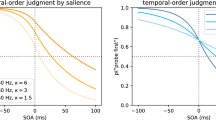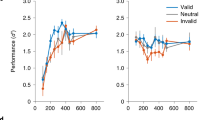Summary
In the literature two different views with regard to the time course of activation of “recognition units” —hypothetical entities that represent identity information —are proposed. Both views are derived from a restricted set of phenomena in visual perception. The first view gets its intuitions from phenomena such as those summarized by Bloch's law; these phenomena show integration or summation of activation over time. This “grow-and-grow” view assumes that recognition units accumulate activation gradually over times The second view finds its inspiration in phenomena such as Mach-bands and simultaneous contrast; these phenomena show inhibition or steady-state suppression over time. This “grow-and-shrink” view assumes that the activation levels increase fast initially and then start to decrease.
The perception literature strongly suggests that it may be light intensity that determines whether mainly integration (and phenomena such as Bloch's law) or inhibition (and phenomena such as Mach-bands) is obtained. So it is also likely that both information-processing views apply only to a limited range of intensity conditions; the “grow-and-grow” view to conditions of low-flight intensities, and the “grow-and-shrink” view to conditions of intermediate-and high-light intensities.
It is argued that, to arrive at a complete view, a visual phenomenon that applies to the complete range of light intensities should be taken as a background for generating hypotheses about time courses in visual-information processing. The Broca-Sulzer effect is such a phenomenon. Starting from this phenomenon a simple, synthesizing, information-processing model is derived that is compatible with both the “grow-and-grow” view and the “grow-andshrink” view. It is shown that, besides the relevant temporal properties, this model also produces the appropriate spatial properties.
Similar content being viewed by others
References
Allport, D. A. (1987). Selection for action: Some behavioral and neurophysiological considerations of attention and action. In H. Heuer and A. F. Sanders (Eds.),Issues ira perception. and action. Hillsdale, NJ: Lawrence Erlbaum.
Barlow, H. B. (1958). Temporal and spatial summation in human vision at different background intensities.Journal of Physiology (London), 141, 337–350.
Bloch, A. M. (1885). Expérience sur la vision.Comptes Rendus de Séances de la Société de Biologie (Paris), 37, 493–495.
Broca, A., & Sulzer, D. (1902). La sensation lumineuse en fonction du temps.Journal de Physiologie et de Pathologie Generale, 4, 632–640.
Coltheart, M. (1975). Iconic memory: A reply to Professor Holding.Memory & Cognition, 3, 42–48.
Coltheart, M. (1980a). Iconic memory and visible persistence.Perception & Psychophysics, 27, 183–228.
Coltheart, M. (1980b). The persistences of vision.Philosophical Transactions of the Royal Society, London, B290, 57–69.
Coltheart, M. (1983). Ecological necessity of iconic memory.Behavioral and Brain Sciences, 6, 17–18.
Cornsweet, T. N. (1970).Visual perception. New York: Academic Press.
Cowey, A. (1979). Why are there so many visual areas? In F. O. Schmitt, F. G. Worden, G. Adelman, and S. G. Dennis (Eds.),The organization of the cerebral cortex. Cambridge, MA: MIT Press.
Cowey, A. (1985). Aspects of cortical organization related to selective attention and selective impairments of visual perception. In M. I. Posner & O. S. M. Marin (Eds.),Attention and Performance XI. Hillsdale, NJ: Lawrence Erlbaum.
Di Lollo, V. (1980). Temporal integration in visual memory.Journal of Experimental Psychology: General, 109, 75–97.
Ditchburn, R. W., & Ginsburg, B. L. (1952). Vision with a stabilized retinal image.Nature, 170, 36–37.
Eriksen, C. W., & Schultz, D. W. (1978). Temporal factors in visual information processing: A tutorial review. In J. Requin (Ed.),Attention and performance VII. Hillsdale, NJ: Lawrence Erlbaum.
Eriksen, C. W., & Schultz, D. W. (1979). Information processing in visual search: A continuous flow conception and experimental results.Perception & Psychophysics, 25, 249–263.
Eriksen, C. W., O'Hara, W. P., & Eriksen, B. (1982). Response competition effects in same-different judgments.Perception & Psychophysics, 32, 261–270.
Ganz, L. (1975). Temporal factors in visual perception. In E. C. Carterette & M. P. Friedman (Eds.),Handbook of perception, Vol.V. New York: Academic Press.
Graham, C. H., & Kemp, E. H. (1938). Brightness discrimination as a function of the duration of the increment intensity.Journal of General Physiology, 21, 635–650.
Grice, G. R., & Gwynne, J. W. (1985). Temporal characteristics of noise conditions producing facilitation and interference.Perception & Psychophysics, 37, 495–501.
Grice, G. R., Boroughs, J. M., & Canham, L. (1984a). Temporal dynamics of associative interference and facilitation produced by visual context.Perception & Psychophysics, 36, 499–507.
Grice, G. R., Canham, L., & Gwynne, J. W. (1984b). Absence of a redundant-signals effect in a reaction time task with divided attention.Perception & Psychophysics, 36, 565–570.
Haber, R. N. (Ed.) (1969).Information processing approaches to visual perception. New York: Holt, Rinehart & Winston.
Haber, R. N. (1983). The impending demise of the icon: A critique of the concept of iconic storage in visual information processing.Behavioral and Brain Sciences, 6, 1–11.
Haber, R. N., & Hershenson, M. (1974).The psychology of visual perception. London: Holt, Rinehart, & Winston.
Hubel, D. H. (1979). The brain.Scientific American, 241, 38–48.
Kahneman, D. (1964). Temporal summation in an acuity task at different energy levels — a study of the determinants of summation.Vision Research, 4, 557–566.
Kahneman, D. (1966). Time intensity reciprocity under various conditions of adaptation and backward masking.Journal of Experimental Psychology, 71, 543–549.
Kahneman, D. (1973).Attention and effort. Englewood Cliffs, NJ: Prentice-Hall.
Kahneman, D., & Norman, J. (1964). The time-intensity relation in visual perception as a function of the observer's task.Journal of Experimental Psychology, 68, 215–220.
Kahneman, D., & Treisman, A. (1984). Changing views of attention and automaticity. In R. Parasuraman & P. R. Davies (Eds.),Varieties of attention. New York: Academic Press.
Krumhansl, C. L. (1982). Abrupt changes in visual stimulation enhance processing of form and location information.Perception & Psychophysics, 32, 511–523.
Larochelle, S., McClelland, J. L., & Rodriguez, E. (1980). Context and the allocation of resources in word recognition.Journal of Experimental Psychology: Human Perception and Performance, 6, 686–694.
Lupker, S. J., & Massaro, D. W. (1979). Selective perception without confounding contribution of decision and memory.Perception & Psychophysics, 25, 60–69.
Massaro, D. W. (1975).Experimental psychology and information processing. Chicago: Rand McNally.
Massaro, D. W. (1983). Icons and iconoclasts.Behavioral and Brain Sciences, 6, 31.
Maunsell, J. H. R., & Newsome, W. T. (1987). Visual processing in monkey extrastriate cortex.Annual Review of Neuroscience, 10, 363–401.
McClelland, J. L. (1979). On the time relations of mental processes: An examination of systems of processes in cascade.Psychological Review, 86, 287–330.
Mewhort, D. J. K., Campbell, A. J., Marchetti, F. M., & Campbell, J. I. D. (1981). Identification, localisation, and “iconic memory”: An evaluation of the bar-probe task.Memory & Cognition, 9, 50–67.
Neisser, U. (1967).Cognitive Psychology. New York: Appleton-Century-Crofts.
Ratliff, F. (1952). The role of physiological nystagmus in monocular acuity.Journal of Experimental Psychology, 43, 163–172.
Rayner, K., Inhoff, A. W., Morrison, P. E., Slowiaczek, M. L., & Bertera, J. H. (1981). Masking of foveal and parafoveal vision during eye fixations in reading.Journal of Experimental Psychology, 7, 167–179.
Roufs, J. A. J. (1972). Dynamic properties of vision. I. Experimental relationships between flicker and flash thresholds.Vision Research, 12, 261–278.
Sanders, A. F. (1983). Towards a model of stress and human performance.Acta Psychologica, 53, 61–97.
Shiffrin, R. M., & Atkinson, R. C. (1969). Storage and retrieval processes in long-term memory.Psychological Review, 76, 179–193.
Shiffrin, R. M., & Schneider, W. (1977). Controlled and automatic human information processing: II. Perceptual learning, automatic attending, and a general theory.Psychological Review, 84, 127–190.
Sperling, G. (1960). The information available in brief visual presentations.Psychological Monograph, 74(11) (whole no. 498).
Stelmach, L. B. (1984). Does rate of processing determine ease of target detection?Journal of Experimental Psychology: Human Perception and Performance, 10, 108–118.
Styles, E. A., & Allport, D. A. (1986). Perceptual integration of identity, location and colour.Psychological Research, 48, 189–200.
Turvey, M. T. (1978). Visual processing and short-term memory. In W. K. Estes (Ed.),Handbook of learning and cognitive processes, Vol.5. Hillsdale, NJ: Lawrence Erlbaum.
Van der Heijden, A. H. C. (1981).Short-term visual information forgetting. London: Routledge & Kegan Paul.
Van der Heijden, A. H. C., Hagenaar, R., & Bloem, W. (1984). Two stages in postcategorical filtering and selection.Memory & Cognition, 12, 458–469.
Author information
Authors and Affiliations
Rights and permissions
About this article
Cite this article
Hagenzieker, M.P., van der Heijden, A.H.C. Time courses in visual-information processing: Some theoretical considerations. Psychol. Res 52, 5–12 (1990). https://doi.org/10.1007/BF00867205
Received:
Accepted:
Issue Date:
DOI: https://doi.org/10.1007/BF00867205




